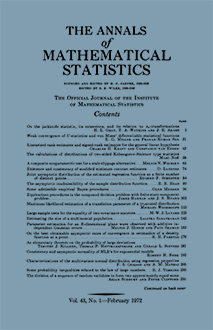Abstract
The mixed model in a 2-way analysis of variance is characterized by a fixed classification, e.g., treatments, and a random classification, e.g., plots or individuals. If we consider $k$ different treatments each applied to everyone of $n$ individuals, and assume the usual analysis of variance assumptions of uncorrelated errors, equal variances and normality, an appropriate analysis for the set of $nk$ observations $x_{ij}, i = 1, 2, \cdots n, j = 1, 2, \cdots k$, is ???? where the $F$ ratio under the null hypothesis has the $F$ distribution with $(k - 1)$ and $(k - 1)(n - 1)$ degrees of freedom. As is well known, if we extend the situation so that the errors have equal correlations instead of being uncorrelated, the $F$ ratio has the same distribution. Under the null hypothesis, the numerator estimates the same quantity as the denominator, namely, $(1 - \rho)\sigma^2$, where $\rho$ is the constant correlation coefficient among the treatments. This case can also be considered as a sampling of $n$ vectors (individuals) from a $k$-variate normal population with variance-covariance matrix $$V = \sigma^2 \begin{pmatrix} 1 & \rho & \cdots & \rho \\ \rho & & & \vdots \\ \vdots & & & \rho \\ \rho & \cdots & \rho & 1\end{pmatrix}.$$ If we consider this type of formulation and suppose the $k$ treatment errors to have a multivariate normal distribution with unknown variance-covariance matrix (the same for each individual), then the usual test described above is valid for $k = 2$. For $k > 2$, and $n \geqq k$, Hotelling's $T^2$ is the appropriate test for the homogeneity of the treatment means. However, the working statistician is sometimes confronted with the case where $k > n$, or he does not have the adequate means for computing large order inverse matrices and would therefore like to use the original test ratio which in general does not have the requisite $F$ distribution. Box [1] and [2] has given an approximate distribution of the test ratio to be $F\lbrack(k - 1)\epsilon, (k - 1)(n - 1)\epsilon\rbrack$ where $\epsilon$ is a function of the population variances and covariances and may further be approximated by the sample variances and covariances. We show in Section 3 that $\epsilon \geqq (k - 1)^{-1}$, and therefore a conservative test would be $F(1, n - 1)$. Box referred only to one group of $n$ individuals. We shall extend his results to a frequently occurring case, namely, the analysis of $g$ groups where the $\alpha$th group has $n_\alpha$ individuals, $\alpha = 1, 2, \cdots g$, and $\Sigma^g_{\alpha = 1} n_\alpha = N$. We will show that the treatment mean square and the treatment $\times$ group interaction can be tested in the same approximate fashion by using the Box procedure.
Citation
Seymour Geisser. Samuel W. Greenhouse. "An Extension of Box's Results on the Use of the $F$ Distribution in Multivariate Analysis." Ann. Math. Statist. 29 (3) 885 - 891, September, 1958. https://doi.org/10.1214/aoms/1177706545
Information





